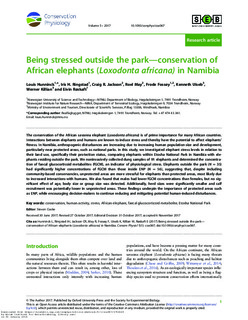| dc.contributor.author | Hunninck, Louis | |
| dc.contributor.author | Ringstad, Iris | |
| dc.contributor.author | Jackson, Craig Ryan | |
| dc.contributor.author | May, Roelof Frans | |
| dc.contributor.author | Fossøy, Frode | |
| dc.contributor.author | Uiseb, Kenneth | |
| dc.contributor.author | Killian, Werner | |
| dc.contributor.author | Røskaft, Eivin | |
| dc.coverage.spatial | Etosha National Park, Namibia, Africa | nb_NO |
| dc.date.accessioned | 2018-01-05T09:46:24Z | |
| dc.date.available | 2018-01-05T09:46:24Z | |
| dc.date.created | 2017-12-20T13:02:47Z | |
| dc.date.issued | 2017 | |
| dc.identifier.issn | 2051-1434 | |
| dc.identifier.uri | http://hdl.handle.net/11250/2475913 | |
| dc.description.abstract | The conservation of the African savanna elephant (Loxodonta africana) is of prime importance for many African countries.
Interactions between elephants and humans are known to induce stress and thereby have the potential to affect elephants’fitness. In Namibia, anthropogenic disturbances are increasing due to increasing human population size and development, particularly near protected areas, such as national parks. In this study, we investigated elephant stress levels in relation to their land use, specifically their protection status, comparing elephants within Etosha National Park in Namibia with elephants residing outside the park. We noninvasively collected dung samples of 91 elephants and determined the concentration
of faecal glucocorticoid metabolites (fGCM), an indicator of physiological stress. Elephants outside the park (N = 35) had significantly higher concentrations of fGCM than those inside ENP (N = 56), suggesting that, despite including community-based conservancies, unprotected areas are more stressful for elephants than protected areas, most likely due to increased interactions with humans. We also found that males had lower fGCM concentrations than females, but no significant
effect of age, body size or group size was detected. Additionally, herd sizes were significantly smaller and calf recruitment was potentially lower in unprotected areas. These findings underpin the importance of protected areas such as ENP, while encouraging decision-makers to continue reducing and mitigating potential human-induced disturbances. | nb_NO |
| dc.language.iso | eng | nb_NO |
| dc.rights | Attribution-NonCommercial-NoDerivatives 4.0 Internasjonal | * |
| dc.rights.uri | http://creativecommons.org/licenses/by-nc-nd/4.0/deed.no | * |
| dc.subject | conservation | nb_NO |
| dc.subject | human activity | nb_NO |
| dc.subject | stress | nb_NO |
| dc.subject | African elephant | nb_NO |
| dc.subject | faecal glucocorticoid metabolite | nb_NO |
| dc.title | Being stressed outside the park — conservation of African elephants (Loxodonta africana) in Namibia | nb_NO |
| dc.type | Journal article | nb_NO |
| dc.type | Peer reviewed | nb_NO |
| dc.description.version | publishedVersion | nb_NO |
| dc.subject.nsi | VDP::Zoologiske og botaniske fag: 480 | nb_NO |
| dc.subject.nsi | VDP::Zoology and botany: 480 | nb_NO |
| dc.source.volume | 5 | nb_NO |
| dc.source.journal | Conservation Physiology | nb_NO |
| dc.source.issue | 1 | nb_NO |
| dc.identifier.doi | 10.1093/conphys/cox067 | |
| dc.identifier.cristin | 1530370 | |
| cristin.unitcode | 7511,2,0,0 | |
| cristin.unitname | Avdeling for terrestrisk økologi | |
| cristin.ispublished | true | |
| cristin.fulltext | original | |
| cristin.qualitycode | 1 | |

